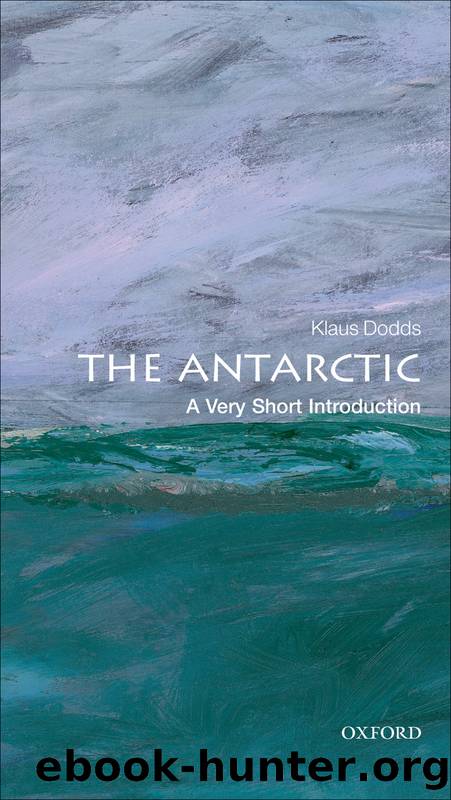The Antarctic by Klaus Dodds

Author:Klaus Dodds
Language: eng
Format: epub
Publisher: OUP Oxford
Published: 2012-02-14T16:00:00+00:00
Chapter 4
Governing the Antarctic
In the midst of a worsening Cold War, the signing and entering into force of the 1959 Antarctic Treaty was a notable achievement. This treaty established a framework for the demilitarization of the Antarctic and the promotion of international cooperation, especially in the field of science. Article 4, as noted earlier, ensured that no new claims to polar territory were to be asserted while the treaty was in force. For the chief architect of the treaty, the United States, this framework was praised for âcontaining all the provisions which the US believed were required for the protection of its national interest and as setting a precedent in the field of disarmament, prohibition of nuclear explosions, and the law of spaceâ. On ratifying the treaty, American senators recognized that with the promotion of scientific cooperation, freedom of access, and peaceful usages of the Antarctic, there was no immediate need for a territorial claim.
Upon the Treatyâs entry into force in June 1961, the Antarctic became the worldâs first nuclear-free zone, and provided inspiration for further denuclearizing initiatives elsewhere. Moreover, the treaty placed peaceful cooperation and scientific collaboration as the core business of the signatories, later to be termed Antarctic Treaty Consultative Parties (ATCPs). Governing by consensus is the sine qua non of those parties. Together, the treaty and subsequent instruments such as the Convention on the Conservation of Living Resources (entry into force, 1982) and the Protocol on Environmental Protection (entry into force, 1998) all make up the Antarctic Treaty System (ATS). Science is frequently described as the core activity, and indicative of ongoing cooperation amongst the parties, subject to no restrictions on location of activity. A constellation of agreements continues to strive to conserve, preserve, and protect the Antarctic terrestrial and marine environments.
These features explain a great deal when it comes to the longevity of the Antarctic Treaty. In the last few years, a number of events, including a high-profile Antarctic Treaty Summit hosted by the Smithsonian Institution at Washington, DC, have celebrated the capacity and willingness of Antarctic Treaty Consultative Parties to govern the Antarctic. At the joint session of the Antarctic Treaty Consultative Parties Meeting and the Arctic Council in April 2009, Secretary of State Hillary Clinton reminded her audience that:
Download
This site does not store any files on its server. We only index and link to content provided by other sites. Please contact the content providers to delete copyright contents if any and email us, we'll remove relevant links or contents immediately.
| Africa | Americas |
| Arctic & Antarctica | Asia |
| Australia & Oceania | Europe |
| Middle East | Russia |
| United States | World |
| Ancient Civilizations | Military |
| Historical Study & Educational Resources |
Magic and Divination in Early Islam by Emilie Savage-Smith;(1492)
Ambition and Desire: The Dangerous Life of Josephine Bonaparte by Kate Williams(1328)
Bohemians, Bootleggers, Flappers, and Swells: The Best of Early Vanity Fair by Bohemians Bootleggers Flappers & Swells- The Best of Early Vanity Fair (epub)(1323)
Papillon by Henry Charrière(1298)
Twelve Caesars by Mary Beard(1229)
Operation Vengeance: The Astonishing Aerial Ambush That Changed World War II by Dan Hampton(1128)
What Really Happened: The Death of Hitler by Robert J. Hutchinson(1113)
London in the Twentieth Century by Jerry White(1097)
Time of the Magicians by Wolfram Eilenberger(1074)
Twilight of the Gods by Ian W. Toll(1069)
The Japanese by Christopher Harding(1067)
Lenin: A Biography by Robert Service(1027)
The Devil You Know by Charles M. Blow(970)
A Social History of the Media by Peter Burke & Peter Burke(926)
Freemasons for Dummies by Hodapp Christopher;(911)
Napolean Hill Collection by Napoleon Hill(890)
Henry III by David Carpenter;(882)
The Churchill Complex by Ian Buruma(874)
The Rise and Triumph of the Modern Self by Unknown(872)
